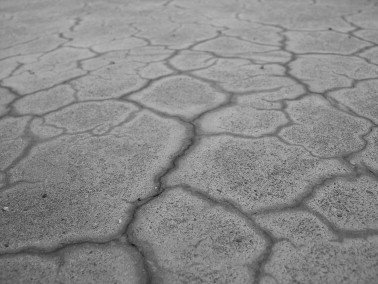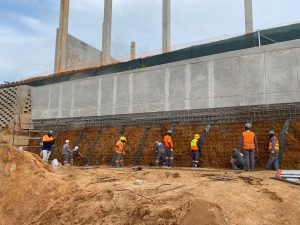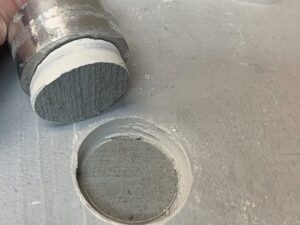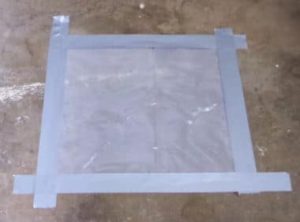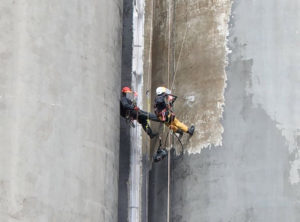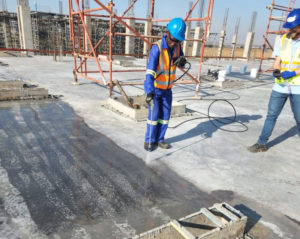By Carl White
Our colloidal silica post-placement pozzolan technology reduces drying shrinkage.
One of the challenges associated with concrete is that it shrinks, a change in volume that can lead to cracks in concrete structures.
Concrete shrinkage is as a result of a loss of water that is retained in the pore structure of the concrete. The pores or voids are formed as concrete is produced and reaches its compressive strength. They consist of bleed water channels, capillaries, entrapped air voids and those that have occurred naturally. Interconnected pores provide a pathway through which water and water vapour is able to pass to reach the air above the concrete and evaporate. Although most noticeable during about the first 24 hours, this process continues for several days, weeks or months. In mass concrete, it can even persist for years. Meanwhile, non-evaporable water is permanently trapped within the structure.
The liquid within the pore structure of concrete is correctly termed “pore solution”. This is considering that it contains various dissolved or suspended ions and salts. Given a constant composition of pore solution, the rate of drying shrinkage is mostly dependent on the evaporation rate. Evaporation rate is determined by ambient and concrete temperature; relative humidity; and wind speed. In general, greater winds and temperatures, as well as lower humidity leads to quicker losses in moisture. When concrete dries faster than the development of its tensile strength, drying shrinkage cracks can occur. Maintaining moisture levels for an extended period is, therefore, very important. This is achieved by sustaining the correct temperatures and curing. Curing slows drying and provides a continued supply of water for the hydration of cementitious materials to continue.
Colloidal silica facilitates curing
Colloidal-silica post-placement pozzolan technology facilitates curing.
“Drying” and “curing” are often incorrectly used interchangeably, especially when referring to concrete that will receive flooring materials. Drying refers to the loss of moisture from concrete over time. Curing entails intentionally retaining moisture in the concrete to facilitate continuation of the cement hydration process. For most adhesives and flooring products to perform appropriately, concrete needs to be of a relative humidity and below a specific percent moisture. However, adhesive and flooring manufacturers are really concerned about the moisture present at the interface between the concrete and the adhesive and/or flooring. The general moisture condition is sufficient to describe the entire system for concrete that has not been treated with SCP products.
SCP products react with available alkalis to close bleed water channels and capillaries with reaction products. This action retains moisture in the concrete. The surface of the concrete is able to achieve a “dry” condition and, therefore, receive adhesives and flooring. Meanwhile, the concrete’s internal structure is kept at a high level of moisture for continued curing. When using our products, a description of the entire system based on a total percentage of moisture or relative humidity is no longer appropriate. This is considering that water and water vapour transport mechanisms are significantly affected. The surface of the concrete is, therefore, able to act independently of the total slab moisture content.
Colloidal silica applied to surface
Colloidal silica post-placement pozzolan technology is applied to the surface of the concrete shortly after the completion of finishing operations. SCP consists primarily of colloidal silica that are made up of very small silicon dioxide particles suspended in water. The colloidal silica enters the concrete through bleed water channels and capillaries. It penetrates deeply and combines with some of the existing pore solution. Introducing a solute is the simplest way of changing the water’s surface tension. SCP introduces suspended silica particles into the pore solution changing its surface tension and contact angle. This reduces pore pressure that leads to dry-shrinkage cracking.
The mechanics of how concrete shrinks when drying has been studied extensively. According to ACI 231R-10 Report, Early Age Cracking: Causes, Measurement, and Mitigation, the loss of pore water results in the development of a meniscus and capillary pressure in pores. The radius of the meniscus may be directly related to the extent of capillary pressure that is formed using the Young-Laplace equation:
σcap = 2γ • cosθ
___________
r
σcap is pore pressure, γ is the surface tension of the pore fluid in N/m; θ (rad) is the contact angle between pore fluid and solids; and r is the radius of the menisci in metres. It can be observed that the pore pressure increases as pore diameter (meniscus radius) decreases. This pore pressure is the prevailing force by which drying shrinkage occurs – the pressure pulls on the pore walls. By reducing the surface tension of the pore fluid (γ) and the corresponding reductions that occur in the contact angle (θ), it is possible to decrease the pressure that is generated.
Colloidal silica reacts with alkalis
Our colloidal silica post-placement pozzolan reacts with alkalis in the concrete to close the pores by mainly forming calcium silicate hydrate. This pozzolanic reaction makes the pore structure less continuous and significantly reduces the transport of water through the concrete. This action retains water that normally would evaporate, slowing the rate of drying significantly. Changing the chemistry of the pore solution and then shutting down liquid transport greatly reduces drying shrinkage of concrete. Testing has demonstrated a typical decrease of between 40% and 60% of drying shrinkage at 28 days of SCP-treated concrete compared to controls.
Learn more about state-of-the-art colloidal silica post pozzolan technology. www.spraylockafrica.co.za

